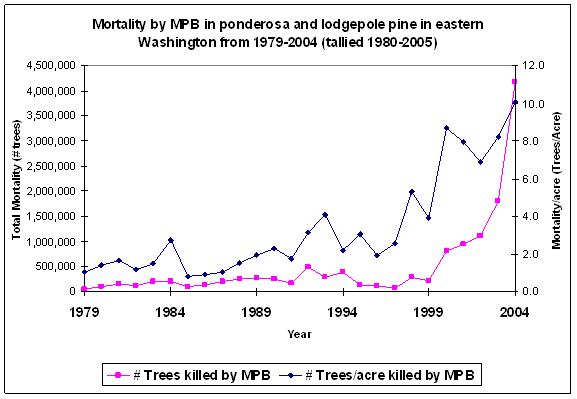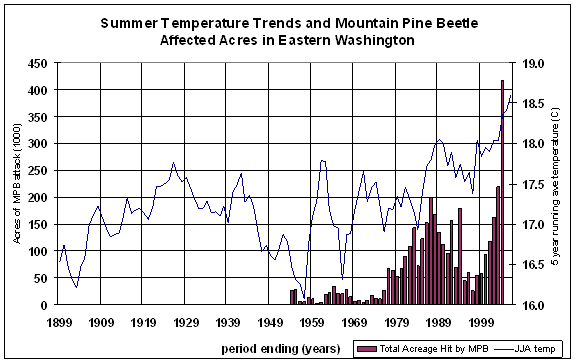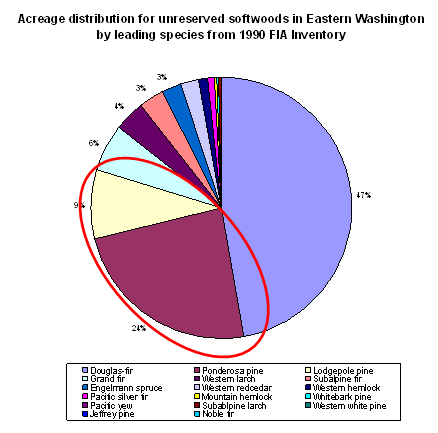Data from the Washington State Department of Natural Resources (DNR) insect and disease aerial survey over eastern Washington is collected by DNR and maintained at the USFS Forest Health Protection branch. Digital maps containing location detail and information on the type, intensity, and extent of forest damage were downloaded from the Forest Health Protection site at http://www.fs.fed.us/r6/nr/fid/as/index.shtml for the years of 1980 to 2005. The data was imported into an ARCGIS 9.0 database and queried to identify all polygons where
mountain pine beetle
(MPB) had attacked either ponderosa pine (PP) or lodgepole pine (LPP) over the 26 year period across all forested land in eastern Washington. Aerial surveys data for assessing MPB impact captures predominantly ‘red attack’, which is the point when the tree’s needles turn red in the year following successful MPB attack. Thus the aerial survey estimate of attack in the 1980 aerial survey actually reports the mortality that occurred in 1979 because the survey methodology can only positively identify trees that have been killed the year prior to the aerial survey itself. By adjusting aerial survey data for this time lag, we explored relationships between MPB attack, forest attributes and climate data to elucidate likely causes for elevated mortality levels in low and mid elevation pine species. Figure 1 shows the mortality per acre of ponderosa pine (PP) and lodgepole pine (LPP) for the affected acres across all eastern Washington increasing from 2.2 for1979-1999 to 8.4 for 2000-2004. Total mortality is increasing even faster as more acres are being affected each year. The mortality increase in 2004 alone, shows MPB affected over 415,000 acres resulting in over 4 million dead pine trees in Eastern Washington (red attack observed in 2005) out of a total of 7.3 million trees killed by all insects, disease, animals, and weather damage across the entire state.
Aerial data for this most recent 25 year period indicate that approximately 80% of the pine mortality has occurred since the forest inventory on eastside forests was completed in the early to mid 1990’s under either the Forest Inventory and Analysis (FIA) or the Current Vegetation Survey (CVS) program. Inventory updates using the modified plot parameters and annual re-survey methods have not captured sufficient data to account for the level and extent of mortality in the ensuing years. In particular, the increase in mortality rates since 2000 has not been captured with ground inventory methods. It is estimated that the mortality in lodgepole occurring on state and private forests is 72% of total mortality for the 25 year period. In the same five year time frame, national forests have experienced 70% of their total lodgepole mortality.


 |
Figure 1: Time series of mortality from MPB in Eastern Washington by reporting period. |
In order to determine if a historical analogue exists for the level and extent of mortality we have witnessed in the past five years, a review of available insect and disease surveys was completed for eastern Washington. That review suggests that lodgepole and ponderosa pine mortality from mountain pine beetle has historically been less than 50,000 acres of infestation per year for as far back as aerial survey records are available (Figure 2). Ground survey data from an earlier era (1928-1937) suggests that early 20th century mountain pine beetle outbreaks in eastern Washington killed approximately 1 %/year of the standing inventory in the affected areas. The disparity between historical outbreak conditions and the current situation suggest that there is no historical analogue to the current outbreak in either mortality rate or acres affected.
The lack of a historical analogue to the current outbreak suggests that we must rely on knowledge of forest dynamics to predict the likely short and long term consequences of the current outbreak. In coming up with hypotheses on probable causes for the spike in mortality and acres hit by MPB, we examined climate trends in both the recent past and as far back as records exist. Using data from the Western Regional Climate Center (http://www.wrcc.dri.edu) average monthly values for temperature and precipitation were determined for the East Cascades (06) and NE Washington climate divisions (09) for the entire period of record (1895-2006) and the subset of records for the 1979-1999 period corresponding to the era of more or less endemic MPB activity reported in the aerial survey, and the 2000-2004 period where MPB mortality is escalating. These data indicate that there is an increase in temperature of 0.4-1.0 degree F in NE Washington and 1.9-2.8 degrees F in the East Cascade region for the June through August period of 2000-2004 relative to the same months of 1979-1999. The substantial increase in summer temperature in the East Cascade region is highly correlated with extensive MPB mortality in the region. A similar jump in average summer temperatures in the early 1980’s is correlated with extensive mortality from MPB in NE Washington forests. A five year running average of temperature for these three months was calculated for the entire historical record as shown in Figure 2 with an overlay of pine mortality data for the era where records are available and comparable to the modern record. From Figure 2, it appears that both the increased summer temperatures and the extent of mortality have no historical analogue in the long term record.


 |
Figure 2: Temperature trends and MPB activity in eastern Washington on PP and LLP forests. |
Knowledge of tree physiology suggests that the pine mortality we are witnessing presages an increase in overall mortality impacts that we can expect if temperature trends continue on their current trajectory. Pines role as ‘canary in the coal mine’ arises because they are more sensitive than other tree species to shifts in environmental dryness as measured by vapor pressure deficit (VPD) (Delucia et al 2000) which increases exponentially relative to temperature increases (Waring and Running 1998). Pines also tolerate fewer years of stress than more shade tolerant species before succumbing to mortality (Keane et al, 1996). And finally, the average VPD for the growing season months of June, July and August has reached a threshold value at which most tree species begin to exponentially decrease their stomatal conductance and shut down respiration to maintain water status (Waring and Schlesinger 1985). This shut down mechanism poses a significant risk for pines as it coincides with the time period when MPB activity is at its height and the pitching response is required for effective physiological defense. Synthesis of elements of tree physiology, temperature and moisture trends, and MPB outbreak conditions suggests that we may be facing the loss of a substantial component of our pine inventory in eastern Washington. As pine comprises approximately 33% of total inventory (9% lodgepole, 24% ponderosa) there is cause for grave concern for all owner groups that have pine inventory (Figure 3). As has been demonstrated in central British Columbia, once epidemics of this magnitude get established, the MPB population trends which are also enhanced by increasing temperatures become a driving force that impacts even the healthiest and most resilient forests on the landscape.


 |
Figure 3: Pine forest types of eastern Washington |
The climate trend data would indicate that other tree species and forest types are also at risk as they are experiencing the same gradient of environmental stress as that of the pines. While mortality impacts are not currently as substantial for Douglas-fir as they are for the pines, there are significant outbreaks of spruce budworm and Douglas-fir bark beetle. While more research is required to elucidate likely impacts, elevated mortality trends on pine species and Douglas-fir combined would affect 80% of our forest types in eastern Washington. If temperature and vapor pressure deficits remain outside of their historic range, efforts to address forest health problems by emulating historic disturbances cannot be expected to maintain stands in their historic dynamic range. We appear to be at a most critical juncture for addressing forest health concerns.


References:
DeLucia, E. H., H. Maherali, et al. (2000). "Climate-driven changes in biomass allocation in pines." Global Change Biology 6(5): 587-593.
Keane, RE, P Morgan and SW Running, 1996, FIRE-BGC, Res Pap INT-RP-484, USDA FS, RMRS, Ogden, UT, 122 pp.
Waring, R. H. and W. H. Schlesinger (1985). Forest Ecosystems: Concepts and Management. Orlando, FL, Academic Press.
Waring, R. H. and S. W. Running (1998). Forest Ecosystems: Analysis at Multiple Scales, San Diego, CA, Academic Press.
|












